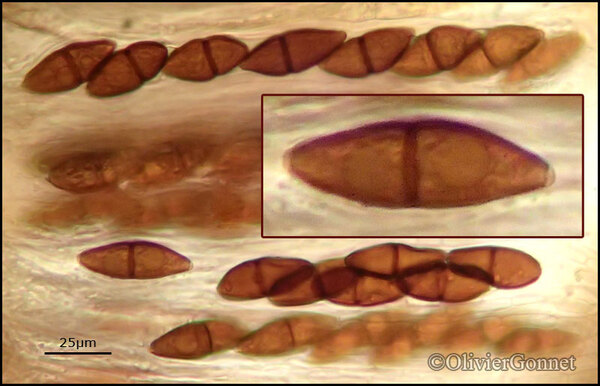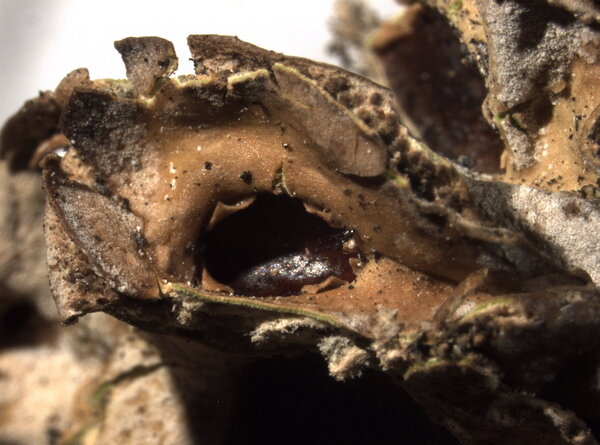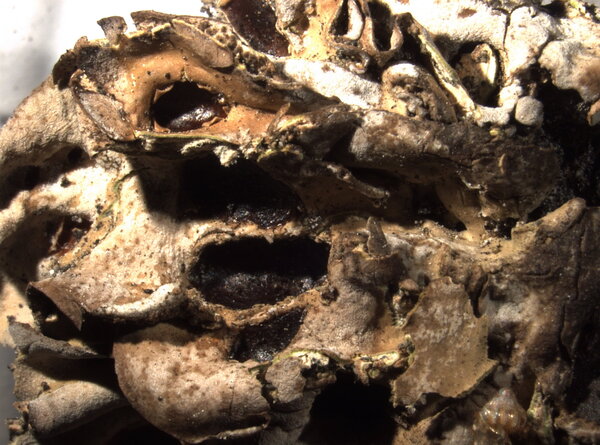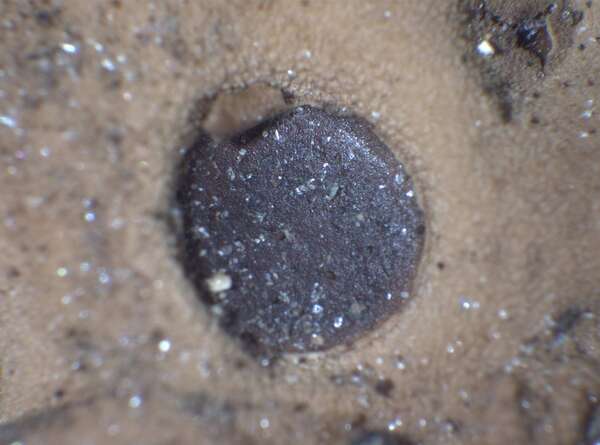Solorina octospora (Arnold) Arnold
Verh. Kaiserl.-Königl. zool.-bot. Ges. Wien, 26: 371, 1876.. Basionym: Solorina saccata var. octospora Arnold - Verh. zool.-bot. Ges. Wien, 23: 103, 1873.
Synonyms:
Distribution: N - Ven (Nascimbene & Caniglia 2000, 2003c, Tomaselli & al. 2006), TAA (Nascimbene & al. 2006, Watson 2014), Lomb, Piem (Isocrono & al. 2004).
Description: Thallus foliose, heteromerous, dorsiventral, forming up to 10(-12) cm wide rosettes. Lobes (8-)10-20(-30) mm broad, rounded, usually epruinose, concave with raised margins, the upper surface scabrous, pale greyish-green to reddish brown, bright green when wet, the lower surface pale brown, indistinctly veined, tomentose, with scattered, whitish to brown rhizines. Upper cortex paraplectenchymatous, lower cortex absent; medulla white, often hosting internal cephalodia which are visible from the lower side as dark spots. Apothecia frequent, rounded, semi-immersed, to 7 mm across, with a brown to brown-black, concave disc, without a thalline margin Proper exciple poorly developed; epithecium brownish; hymenium colourless; paraphyses coherent, not anastomosing, simple, the apical cells hardly swollen; hypothecium pale brown. Asci 8-spored, clavate, fissitunicate, the thickened apex with a K/I+ blue ring, Peltigera-type. Ascospores 1-septate, constricted at septum, dark brown, ellipsoid, 35-40 x (14-)16-21 μm, with a thick, reticulately ornamented wall. Photobiont chlorococcoid (Coccomyxa), with Nostoc in the internal cephalodia. Spot tests: upper cortex and medulla K-, C-, KC-, P-, UV-; medulla sometimes KC+ pink. Chemistry: without lichen substances or medulla with methylgyrophorate. Note: an arctic-alpine to boreal-montane, probably circumpolar lichen found on soil rich in humus and on terricolous mosses, often in rock fissures, usually on calciferous substrata, with optimum above treeline, reaching the nival belt in the Alps; most probably restricted to the Alps in Italy.
Growth form: Foliose, broad lobed
Substrata: soil, terricolous mosses, and plant debris
Photobiont: green algae other than Trentepohlia
Reproductive strategy: mainly sexual
Commonnes-rarity: (info)
Alpine belt: rather rare
Subalpine belt: very rare
Oromediterranean belt: absent
Montane belt: absent
Submediterranean belt: absent
Padanian area: absent
Humid submediterranean belt: absent
Humid mediterranean belt: absent
Dry mediterranean belt: absent

Predictive model
Herbarium samples

Courtesy Danièle et Olivier Gonnet - Source: https://www.afl-lichenologie.fr/Photos_AFL/Photos_AFL_S/Text_S2/Solorina_octospora.htm
France, 3/8/2013 - Mont Cenis - Savoie
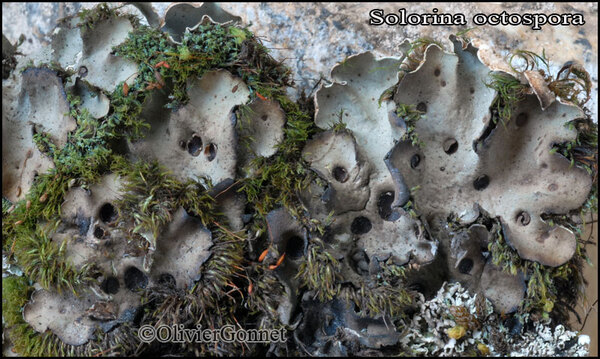
Courtesy Danièle et Olivier Gonnet - Source: https://www.afl-lichenologie.fr/Photos_AFL/Photos_AFL_S/Text_S2/Solorina_octospora.htm
France, 3/8/2013 - Mont Cenis - Savoie

Courtesy Danièle et Olivier Gonnet - Source: https://www.afl-lichenologie.fr/Photos_AFL/Photos_AFL_S/Text_S2/Solorina_octospora.htm
France, 3/8/2013 - Mont Cenis - Savoie
Growth form: Foliose, broad lobed
Substrata: soil, terricolous mosses, and plant debris
Photobiont: green algae other than Trentepohlia
Reproductive strategy: mainly sexual
Commonnes-rarity: (info)
Alpine belt: rather rare
Subalpine belt: very rare
Oromediterranean belt: absent
Montane belt: absent
Submediterranean belt: absent
Padanian area: absent
Humid submediterranean belt: absent
Humid mediterranean belt: absent
Dry mediterranean belt: absent

Predictive model
| Herbarium samples |

Courtesy Danièle et Olivier Gonnet - Source: https://www.afl-lichenologie.fr/Photos_AFL/Photos_AFL_S/Text_S2/Solorina_octospora.htm
France, 3/8/2013 - Mont Cenis - Savoie

Courtesy Danièle et Olivier Gonnet - Source: https://www.afl-lichenologie.fr/Photos_AFL/Photos_AFL_S/Text_S2/Solorina_octospora.htm
France, 3/8/2013 - Mont Cenis - Savoie

 DOLICHENS
DOLICHENS
